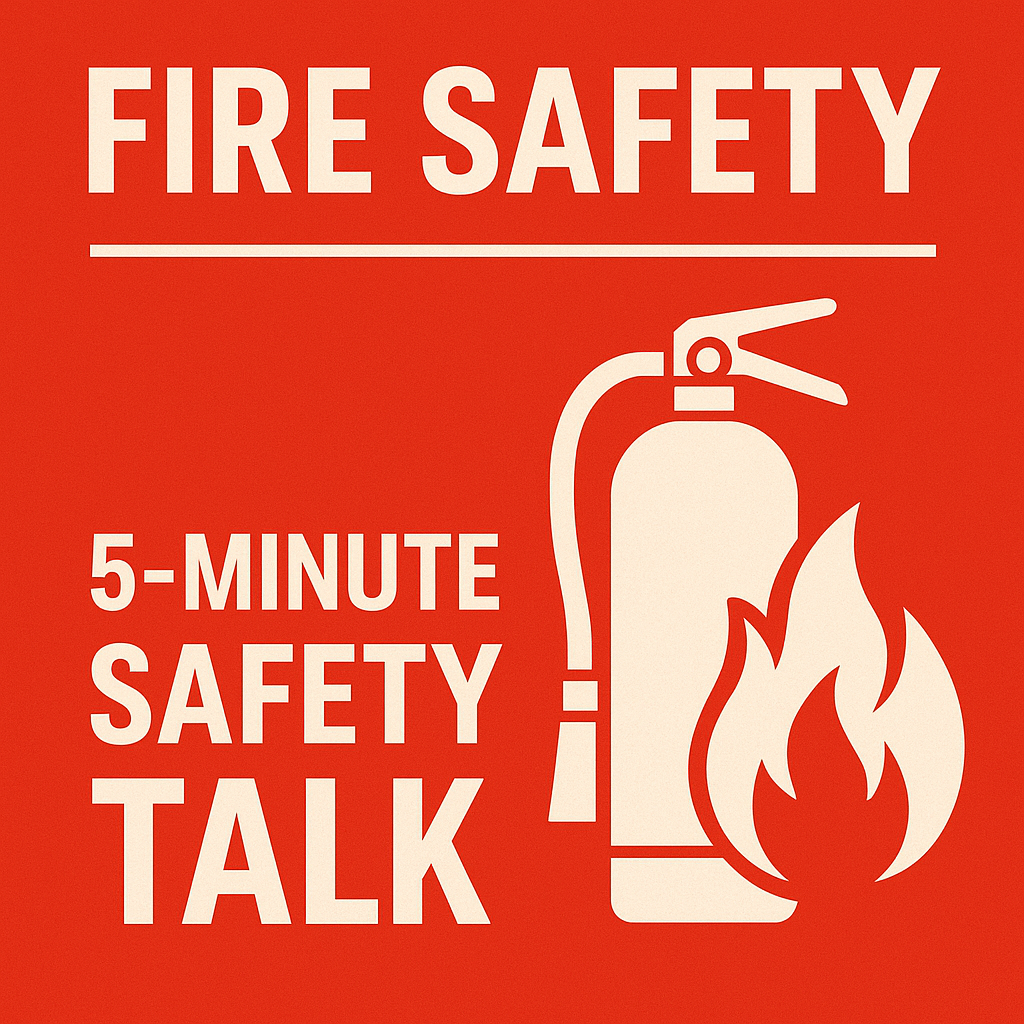
Fire Safety 5 Minute Safety Talk
Good morning team,
Today, let’s spend a few minutes talking about something that can turn deadly in seconds—fire.
Fires are fast, destructive, and unforgiving. They don’t give you a second chance. Whether we work in construction, maintenance, warehousing, or even an office setting, the risk of fire is always there. That’s why knowing how to prevent fires and what to do if one starts can literally save lives.
Let’s take five minutes to refresh ourselves on the basics of fire safety and how we can protect ourselves and our teammates on site.
Why Fire Safety Is Important
Fires don’t just cause damage—they cause injuries and fatalities. Every year, thousands of workplace fires result in:
- Property damage
- Business interruptions
- Serious injuries like burns or smoke inhalation
- Deaths due to delayed evacuation or improper response
A small spark can become a massive blaze in seconds—especially when fuel and oxygen are present.
The Fire Triangle
To understand how fires start, remember the fire triangle:
- Heat – sparks, hot surfaces, open flames
- Fuel – paper, oil, chemicals, wood, plastic
- Oxygen – found naturally in the air
Take away any one of these, and the fire goes out.
Common Fire Hazards at Work
Stay alert for these fire hazards:
- Overloaded power outlets or faulty wiring
- Flammable liquids not stored properly
- Welding or grinding without fire watch
- Smoking near fuel or combustible areas
- Dust build-up in poorly ventilated areas
- Blocked emergency exits or fire equipment
If you see something unsafe, report it or fix it immediately.
Fire Prevention Tips
Here’s how to reduce the risk of fire:
- Keep work areas clean and free of clutter
- Store flammable materials in approved containers
- Use fire-retardant PPE when required
- Turn off electrical tools when not in use
- Do not smoke in restricted areas
- Report unusual smells or overheating equipment
Fire safety begins with prevention, not response.
Know Your Fire Extinguishers
There are different types of fire extinguishers for different fire classes:
- Class A – Ordinary combustibles (wood, paper)
- Class B – Flammable liquids (gasoline, oil)
- Class C – Electrical fires
- Class D – Metals (magnesium, titanium)
- Class K – Kitchen fires (cooking oil)
Always check the label before using an extinguisher.
How to Use a Fire Extinguisher – The PASS Method
If it’s safe to extinguish a small fire, remember PASS:
- P – Pull the pin
- A – Aim at the base of the fire
- S – Squeeze the handle
- S – Sweep side to side
Only attempt this if the fire is small, you’re not trapped, and you have a clear escape path.
Evacuation – Get Out Fast
If you hear a fire alarm or see smoke:
- Don’t assume it’s a drill
- Leave your tools and evacuate immediately
- Use marked emergency exits—never elevators
- Stay low to avoid smoke
- Head to the designated assembly area
Every second counts. Don’t delay.
Quick Fire Safety Checklist
- Are fire extinguishers accessible and inspected?
- Are flammable materials stored correctly?
- Are exits clear and visible?
- Are power cords and plugs in good condition?
- Are “No Smoking” signs followed in restricted areas?
Check these daily—because fire risks don’t take breaks.
Real-Life Example
At a facility in India, a welder left a torch on after use, and nearby cardboard boxes caught fire. The flames spread rapidly, and the building had to be evacuated. Fortunately, the fire was controlled, but the company faced major downtime and a financial hit.
One moment of carelessness—big consequences.
What Not to Do During a Fire
- Don’t try to be a hero—call for help
- Don’t open doors without checking for heat
- Don’t go back for personal items
- Don’t block exits for any reason
- Don’t use water on electrical or oil fires
Safety comes first—always.
Fire Safety Is Everyone’s Responsibility
Don’t wait for the safety officer to catch an issue. If you notice:
- Damaged wires
- Overheated machinery
- Poor housekeeping
- Flammable items lying around
Say something. Do something.
Conclusion
To sum it up—fire safety isn’t optional. A fire can start anytime, anywhere. The good news is that most workplace fires are preventable. All it takes is attention, action, and a few safety habits practiced daily.
Check your surroundings. Know your emergency routes. Use the right extinguisher. Most importantly—act fast, stay calm, and get out safely.
Because when it comes to fire—seconds matter.
Housekeeping 5 Minute Safety Talk
Create Your Own Toolbox Talk Presentation – Step-by-Step
Slips, Trips, and Falls Safety Talk
Fall Protection Systems Safety Talk
Compressed Gas Cylinder Safety Talk
5 Unique FAQs
Q1: Can I use any fire extinguisher on any type of fire?
No. Using the wrong extinguisher can worsen a fire. For example, don’t use water on electrical or oil fires.
Q2: How often should we inspect fire extinguishers?
Monthly visual checks and yearly maintenance are standard. Check pressure gauges and tags regularly.
Q3: What should I do if my exit is blocked by fire?
Find an alternative route. If trapped, seal doors, signal for help, and stay low to avoid smoke inhalation.
Q4: Is it okay to return inside after the fire alarm stops?
Never re-enter until emergency personnel say it’s safe—even if the alarm stops.
Q5: Are fire drills necessary?
Yes. Regular drills help everyone stay prepared and ensure quick, safe evacuations during real emergencies.